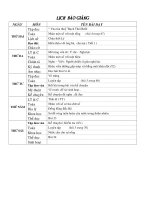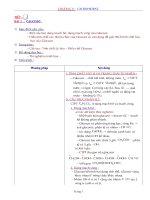Bài soạn Chapter 12 Solutions
Bạn đang xem bản rút gọn của tài liệu. Xem và tải ngay bản đầy đủ của tài liệu tại đây (5.95 MB, 98 trang )
Chapter 12
Solutions
2011, NKMB Co., Ltd.
Chemistry, Julia Burdge, 2
st
Ed.
McGraw Hill.
Mr. Truong Minh Chien ;
/>
2
Solution
•
homogeneous mixtures
composition may vary from one sample to another
appears to be one substance, though really contains
multiple materials
•
most homogeneous materials we encounter are
actually solutions
e.g., air and sea water
•
nature has a tendency toward spontaneous mixing
generally, uniform mixing is more energetically
favorable
Chemistry, Julia Burdge, 2
nd
e., McGraw Hill.
Solutions animation
3
Chemistry, Julia Burdge, 2
nd
e., McGraw Hill.
4
Solutions
•
solute is the dissolved substance
seems to “disappear”
“takes on the state” of the solvent
•
solvent is the substance solute
dissolves in
does not appear to change state
•
when both solute and solvent have
the same state, the solvent is the
component present in the highest
percentage
•
solutions in which the solvent is
water are called aqueous solutions
Chemistry, Julia Burdge, 2
nd
e., McGraw Hill.
5
Seawater
•
drinking seawater will dehydrate you and give
you diarrhea
•
the cell wall acts as a barrier to solute moving
•
the only way for the seawater and the cell
solution to have uniform mixing is for water to
flow out of the cells of your intestine and into
your digestive tract
Chemistry, Julia Burdge, 2
nd
e., McGraw Hill.
6
Common Types of Solution
Solution Phase
Solute
Phase
Solvent
Phase Example
gaseous solutions gas gas
air (mostly N
2
& O
2
)
liquid solutions
gas
liquid
solid
liquid
liquid
liquid
soda (CO
2
in H
2
O)
vodka (C
2
H
5
OH in H
2
O)
seawater (NaCl in H
2
O)
solid solutions solid solid brass (Zn in Cu)
•
solutions that contain Hg and some other metal are
called amalgams
•
solutions that contain metal solutes and a metal solvent
are called alloys
Chemistry, Julia Burdge, 2
nd
e., McGraw Hill.
7
Brass
Type Color % Cu % Zn Density
g/cm
3
MP
°C
Tensile
Strength
psi
Uses
Gilding redish 95 5 8.86 1066 50K pre-83 pennies,
munitions, plaques
Commercial bronze 90 10 8.80 1043 61K door knobs,
grillwork
Jewelry bronze 87.5 12.5 8.78 1035 66K costume jewelry
Red golden 85 15 8.75 1027 70K electrical sockets,
fasteners & eyelets
Low deep
yellow
80 20 8.67 999 74K musical instruments,
clock dials
Cartridge yellow 70 30 8.47 954 76K car radiator cores
Common yellow 67 33 8.42 940 70K lamp fixtures,
bead chain
Muntz metal yellow 60 40 8.39 904 70K nuts & bolts,
brazing rods
Tro, Chemistry: A Molecular Approach 8
Solubility
•
when one substance (solute) dissolves in another
(solvent) it is said to be soluble
salt is soluble in water
bromine is soluble in methylene chloride
•
when one substance does not dissolve in another it is
said to be insoluble
oil is insoluble in water
•
the solubility of one substance in another
depends on two factors – nature’s tendency
towards mixing, and the types of
intermolecular attractive forces
Tro, Chemistry: A Molecular Approach 9
Spontaneous Mixing
Tro, Chemistry: A Molecular Approach 10
Solubility
•
there is usually a limit to the solubility of one
substance in another
gases are always soluble in each other
two liquids that are mutually soluble are said to be
miscible
alcohol and water are miscible
oil and water are immiscible
•
the maximum amount of solute that can be dissolved
in a given amount of solvent is called the solubility
•
the solubility of one substance in another varies with
temperature and pressure
Tro, Chemistry: A Molecular Approach 11
Mixing and the Solution Process
Entropy
•
formation of a solution does not necessarily
lower the potential energy of the system
the difference in attractive forces between atoms of
two separate ideal gases vs. two mixed ideal gases
is negligible
yet the gases mix spontaneously
•
the gases mix because the energy of the system
is lowered through the release of entropy
•
entropy is the measure of energy dispersal
throughout the system
•
energy has a spontaneous drive to spread out
over as large a volume as it is allowed
Tro, Chemistry: A Molecular Approach 12
Intermolecular Forces and the Solution Process
Enthalpy of Solution
•
energy changes in the formation of most solutions also
involve differences in attractive forces between particles
•
must overcome solute-solute attractive forces
endothermic
•
must overcome some of the solvent-solvent attractive
forces
endothermic
•
at least some of the energy to do this comes from
making new solute-solvent attractions
exothermic
Tro, Chemistry: A Molecular Approach 13
Intermolecular Attractions
Dissolution animation 1
Tro, Chemistry: A Molecular Approach 14
Dissolution animation 2
Tro, Chemistry: A Molecular Approach 15
Relative Interactions and Solution Formation
•
when the solute-to-solvent attractions are weaker than
the sum of the solute-to-solute and solvent-to-solvent
attractions, the solution will only form if the energy
difference is small enough to be overcome by the
entropy
Solute-to-Solvent >
Solute-to-Solute +
Solvent-to-Solvent
Solution Forms
Solute-to-Solvent =
Solute-to-Solute +
Solvent-to-Solvent
Solution Forms
Solute-to-Solvent <
Solute-to-Solute +
Solvent-to-Solvent
Solution May or
May Not Form
Tro, Chemistry: A Molecular Approach 16
Solution Interactions
Tro, Chemistry: A Molecular Approach 17
Will It Dissolve?
•
Chemist’s Rule of Thumb –
Like Dissolves Like
•
a chemical will dissolve in a solvent if it has a similar
structure to the solvent
•
when the solvent and solute structures are similar, the
solvent molecules will attract the solute particles at
least as well as the solute particles to each other
Tro, Chemistry: A Molecular Approach 18
Classifying Solvents
Solvent Class
Structural
Feature
Water, H
2
O polar O-H
Methyl Alcohol, CH
3
OH polar O-H
Ethyl Alcohol, C
2
H
5
OH polar O-H
Acetone, C
3
H
6
O polar C=O
Toluene, C
7
H
8
nonpolar C-C & C-H
Hexane, C
6
H
14
nonpolar C-C & C-H
Diethyl Ether, C
4
H
10
O nonpolar C-C, C-H & C-O,
(nonpolar > polar)
Carbon Tetrachloride nonpolar C-Cl, but symmetrical
Tro, Chemistry: A Molecular Approach 19
Example 12.1a − predict whether the following
vitamin is soluble in fat or water
C
H
C
C
C
O
O
OH
OH
C
H
CH
2
OH
OH
Vitamin C
The 4 OH groups make
the molecule highly
polar and it will also H-
bond to water.
Vitamin C is water
soluble
Tro, Chemistry: A Molecular Approach 20
CH
C
H
C
H
CH
C
C
C
CH
C
C
O
O
CH
3
Example 12.1b − predict whether the following
vitamin is soluble in fat or water
Vitamin K
3
The 2 C=O groups are
polar, but their
geometric symmetry
suggests their pulls will
cancel and the molecule
will be nonpolar.
Vitamin K
3
is fat soluble
Tro, Chemistry: A Molecular Approach 21
Energetics of Solution Formation
•
overcome attractions between the solute particles –
endothermic
•
overcome some attractions between solvent molecules –
endothermic
•
for new attractions between solute particles and solvent
molecules – exothermic
•
the overall ∆H depends on the relative sizes of the ∆H
for these 3 processes
∆H
sol’n
= ∆H
solute
+ ∆H
solvent
+ ∆H
mix
Tro, Chemistry: A Molecular Approach 22
Solution Process
1. add energy in to overcome solute-solute attractions
2. add energy in to overcome some solvent-solvent attractions
3. form new solute-solvent attractions, releasing energy
Tro, Chemistry: A Molecular Approach 23
Energetics of Solution Formation
if the total energy cost for
breaking attractions between
particles in the pure solute and
pure solvent is less than the
energy released in making the
new attractions between the
solute and solvent, the overall
process will be exothermic
if the total energy cost for
breaking attractions between
particles in the pure solute and
pure solvent is greater than the
energy released in making the
new attractions between the
solute and solvent, the overall
process will be endothermic
Energy of Solution animation
Tro, Chemistry: A Molecular Approach 24
Tro, Chemistry: A Molecular Approach 25
Heats of Hydration
•
for aqueous ionic solutions, the energy added to
overcome the attractions between water molecules and
the energy released in forming attractions between the
water molecules and ions is combined into a term called
the heat of hydration
attractive forces in water = H-bonds
attractive forces between ion and water = ion-dipole
∆H
hydration
= heat released when 1 mole of gaseous ions dissolves
in water









